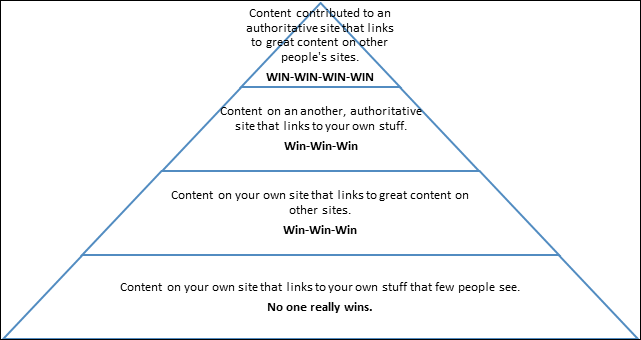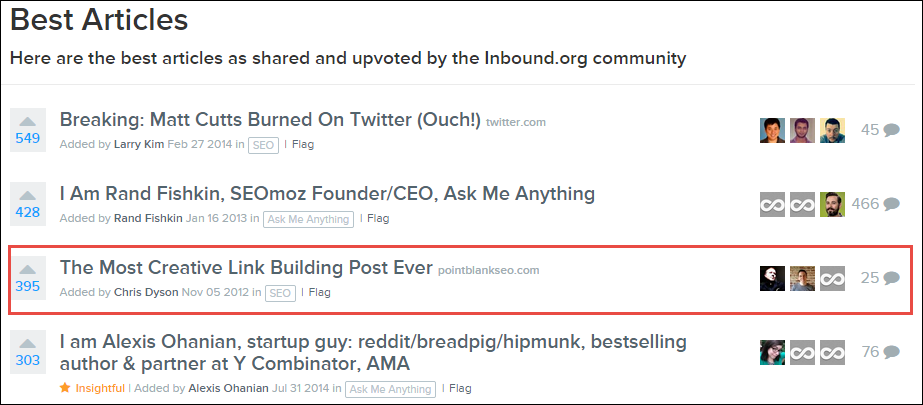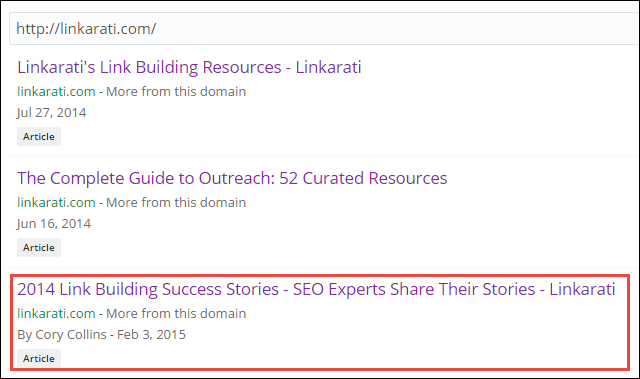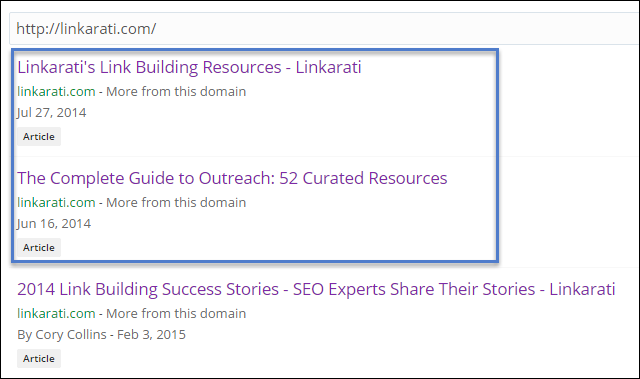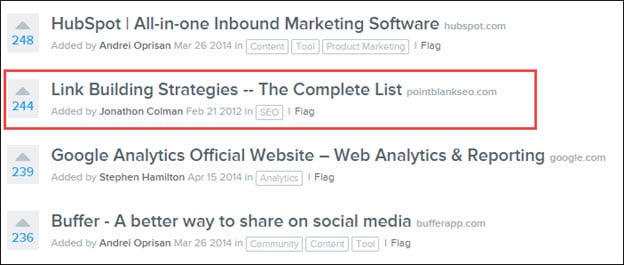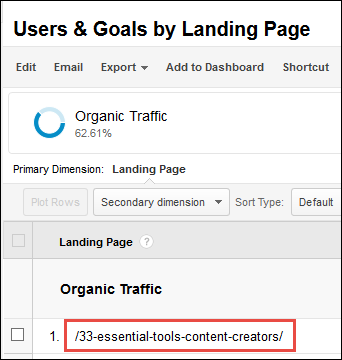When I’m explaining some of the tactics my company leverages in content marketing services to prospects (particularly those who aren’t already doing a lot of content marketing), a question companies often ask is: “wait, so am I understanding this right: you’re linking to other websites in these posts and articles? Why would we want to send people to other people’s websites?!”
If you’re trying to get links, shares, traffic, leads and ultimately sales from your content this mentality is extremely limiting.
In fact, if you’re looking to grow traffic to your own site, it’s really the exact opposite approach that you should be taking. Like Ramit Sethi.
I read Ramit’s blog regularly and enjoy when he’s interviewed various places, and while he doesn’t typically write explicitly about link building or content marketing, a post he recently wrote underlines a general approach to leverage and reciprocity that companies can apply to content creation and promotion: Win Win Win
In the post he outlines an instance where he leveraged a speaking opportunity at a conference to get a ton of extra value out of the speaking slot.
You should read the whole post, but here’s the upshot:
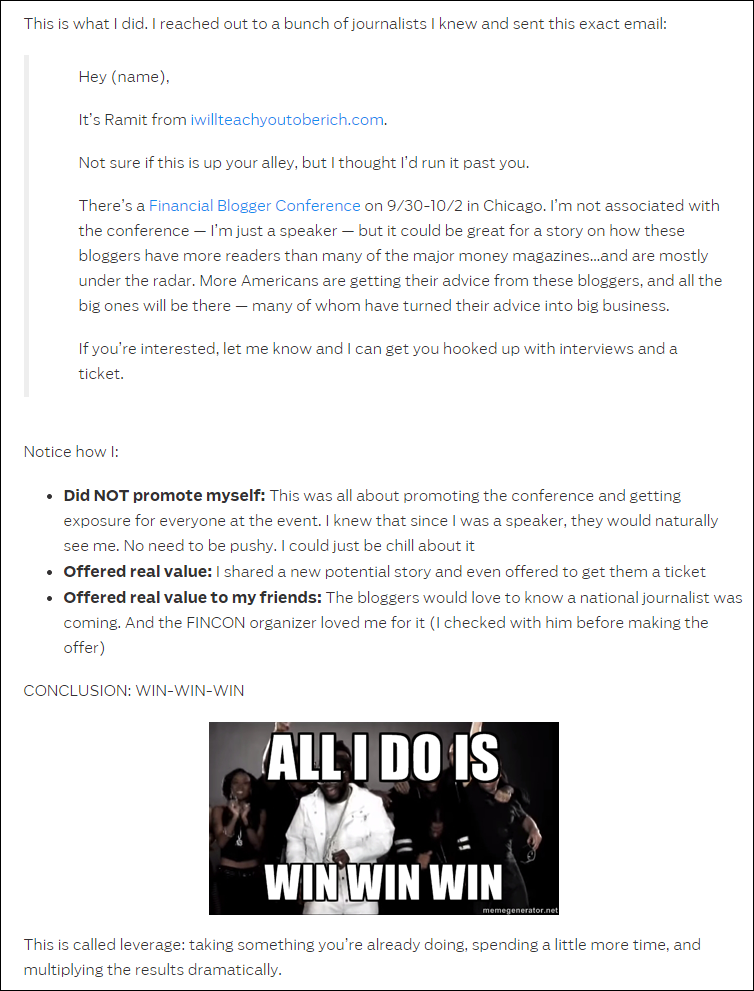 Screen shot of Ramit Sethi's Win Win Win blog post
Screen shot of Ramit Sethi's Win Win Win blog postSo what does the concept of "Win Win Win" have to do with guest posting and the fact that people often hesitate at the idea of linking out?
The success of your content marketing efforts often hinges on the value you create – not just for readers (in creating content) but for sharers and linkers (in promoting content). You can get more traction for your own content by building in as many “wins” for as many people (particularly people who have influence over people you want to reach) as you possibly can.
Here are four examples of how content creation typically creates (or doesn’t) “wins”:
- Lots of companies are creating content on their own site about how great they/their service/their products are. This is content that doesn’t link to anyone else, doesn’t help or teach readers anything, and that very few people see – since they’re not even getting any traffic out of it, no one really wins.
- Some companies are creating useful content on their own sites that links to other great resources on other sites. This is really a “triple win,” as there’s value for the readers, a benefit for the folks who are linked to, and extra value for the content creators (assuming the featured parties are sharing the content and getting some readership).
- Fewer companies are creating great content that they get placed on another authoritative site, which links primarily to their own content or offers. This is another “triple win” in that the contributor gets exposure on a great site, the site they’re contributing to gets some great content, and the reader gets to learn something and consume some great content.
- What’s rarer still is a leveraged approach similar to what Ramit outlined in his post: creating a great piece of content for an authoritative site in your niche that links to, references, and features a wealth of other great content and influencers. This benefits the contributor, the site hosting the content, and the reader in the same way as the last example, but also creates a fourth win for everyone who is featured in the contributed post.
Because the first example is so common, the last example is so rare, and the other examples tend to be in-between in terms of how frequently they’re leveraged, this roughly maps to a sort of pyramid:
By creating all of those wins, you’re maximizing the value of your content. You’re getting great exposure while delivering value for:
- The readers of your content.
- The site you’re contributing to (which may lead to even more value down the line).
- The resources you’re citing in your content (likely building/strengthening relationships that–again–may create even more value for you down the line).
So how do you reach this apex of win and get all of this additional leverage out of the content you’re creating?
Maxing Out Your “Win” Potential
There three basic steps to getting to a place where you’re really maxing out your content’s “win potential”:
Step 1: Create Value for Readers
The first step to ensure you create the maximum number of wins is to create content that’s really valuable to the people who consume it. Creating useful content that solves real problems for readers is table stakes for successful content marketing. While “creating great content” isn't sufficient to build traction for your content, it is necessary. If you’re not creating something that helps readers, you can’t ultimately help the blog you’re contributing to or the people you link to in your content, either.
So you have to understand the types of problems you can solve for your readers (great content ideas) and how best to present solutions for the problem (how to create great content). The good news is there are a lot of great existing resources on the topic of generating useful content ideas and creating great and useful content.
Rand Fishkin recently published a great White Board Friday on creating “Unique Value” in your content:
Unsurprisingly, lots of great content creators have written about the topic of creating great content:
- Aaron Orendorff has a great post that focuses on content that adds value.
- Nate Desmond’s Beginner’s Guide to Content Marketing has some great tips and information on how to create content that’s built to succeed and add specific value.
- Brian Dean’s guide on OKDork.com, Neil Patel’s 30 tips shared here, and Linkarati’s posts on finding content gaps, creating strategic content for links, and generating content ideas all have a ton of great tips and ideas on the topics of content ideation and creation.
Step 2: Get Your Foot in the Additional Value Door
The second step is to secure guest posting and contribution opportunities. This is how you create an additional win for yourself (by getting exposure via someone else’s audience) and a win for the place your content is hosted (which you can’t do if you skip the first step of creating valuable content).
This isn’t your older brother’s guest posting. You’re looking for real blogs with real audiences full of real people you want to reach. You’ll even contribute a post to a place that no follows your link (off-putting for many SEOs, myself included, I know)! It’s OK: you’ll be getting way more links and search traffic later as a result.
As you get started with this process, don’t be overly picky. If you’re writing about lifestyle design, you don’t need to start with a post on Tim Ferriss’ blog. Wins for smaller blogs are still wins, and can frequently lead to access to bigger wins with bigger platforms. One is greater than zero.
Here again we’re in luck, as there is a heap of great content about how to get your content placed on authoritative sites:
- Looking at guest posting guidelines for larger sites is a good start – there’s frequently a lot of overlap. Here is Ramit Sethi’s.
- Here again Aaron Orendorff recently had a great post on rejection and success in getting content on major sites.
- Both the Smart Passive Income Podcast and the Marketing Nerds podcast also covered getting contributor spots on high profile sites.
- You can also follow another guest poster’s lead in identifying places to post and check out any of a number of guest post outreach resources.
Step 3: Spread the Wealth to Other Folks
Once you have an idea of which problems you want to solve for readers, and the capacity to both create that content and get access to real, relevant blogs in your niche, it's time to make your content work even harder for you by highlighting great resources and smart people in your niche. Let’s look at three great ways to do that.
- Interview Smart People
A great tactic for building interesting content while also incentivizing thought leaders to share your content is the “expert roundup” post or “group interview.” This is where you ask a number of thought leaders within a niche a single question, format the answers as a post, and let those folks know when the post is live (spoiler alert: they usually promote the post, as well). This is a list of all of the most popular posts every on Inbound marketing community Inbound.org:
Of everything that’s been shared on Inbound.org, Jon Cooper’s creative link building expert round up / group interview is third, beating out an AMA from the guy whose site popularized AMAs (you’re not going to beat calling out Matt Cutts no matter how many experts you interview, of course).
Using BuzzSumo to look at the most shared posts on this very site (Linkarati) shows a similar story:
The 2014 link building success stories roundup post sits as the third most shared post on the Linkarati site. You can see similar success stories for this type of content various places across the web. The content type works. Journalists have been leveraging quotes from sources in their content for decades – there are even entire networks dedicated to helping make this more efficient for both sides of that interaction.
So why can’t you do the same thing when you contribute a post to a big site? You absolutely can!
Some of the earliest interactions I had with Garrett French of Citation Labs was when he created this kind of content frequently for Search Engine Land and included myself and my business partner Ken Lyons. Since then we’ve hired Garrett and his team, collaborated on projects with him, and linked to him and shared his content various places (including that last sentence).
The short term gain here is that you have a really frequently shared and well-linked to piece of content on an authoritative site that links to your site (a great individual link), but the “long game” in this type of content is that you’re helping get exposure for other folks and building relationships with them as well.
Large group interviews also aren’t the only way to leverage this same principle in contributed posts:
- One-Off Interviews – You can identify a single expert you have a lot of great questions for and interview them one-on-one for a larger site. You’re not citing as many people at once, but again: one is greater than zero.
- One-on-One Interview Series – Similarly you could do a series of interviews with folks for a larger publication. This is great content for the readers, a win for the folks getting interviewed since the exposure they’re getting is on a larger site, and a win for the site you’re doing the interviewing on since you’re doing the leg work for them for free. Pro tip here: do a series of interviews with people in the same field, as at least a few questions that have some overlap, and when you’ve completed the series you’ll have an extra, free post that can serve as a mini-group-interview where you compare the different answers from the series.
If you’re uncertain about how to execute a great expert round up or interview series, Richard Mariott has an in-depth, nuts-and-bolts guide to conducting expert roundups on his site, Brian Lang recently wrote up a great one on Boost Blog Traffic as well, and you can get a better sense of the full range of similar “ego-baiting” possibilities here.
- Highlight Useful Tools & Resources
Let’s look back at those two earlier examples of popular content, first on the Linkarati site:
The two most shared posts were Linkarati’s link building resources post and the complete guide to outreach, which also included a list of curated resources.
Similarly, a little ways down the most popular posts on Inbound.org, we see another post from Jon Cooper:
This doesn’t work just for resource and strategy lists, either. The single post on our site Cornerstone Content that’s gotten the most search traffic over the last 12 months was Jimmy Daly’s contributed post on essential tools for content creators:
These “best tools” types of posts frequently drive a ton of “passive” search traffic over time as people are often looking for long lists/comparisons of tools (or products, depending on your niche) – again, a benefit for the searchers, for the blog (more traffic), and for you (more exposure). It varies from niche to niche and subject to subject obviously, but it’s been my experience that product companies will often happily share a mention of their product or tool at a slightly higher rate than resource lists, so you can do a slightly smaller number and still get some of the same built-in distribution advantages as highlighting a larger list of resources on a topic.
- Link to Great Stuff (Lots of it!)
The last option is pretty simple: just link out frequently to relevant and useful resources in contributed content! You don’t need to create a roundup post or a “best of” list to link out and feature experts. You can just pepper them in in a variety of ways:
- Get a Quick Quote – You can use networks like HARO as a journalist and get quotes from experts, or just ping someone you know for a quick thought on your topic when you know you’re working on something for a larger blog that they have particular expertise in. You could even do this via Skype to incorporate some video content into your post if you’ve worked that out with the place you’re contributing to.
- Highlight an Existing Quote – You can also just identify a great quote or talk or slideshare that someone already gave and highlight that appropriately in your content. This way you get the benefit of highlighting the person and sharing their useful insights without needing them to even participate.
- Know What to Link To – Make linking to great stuff something that’s baked deeply into your content consumption and creation process. Use Feedly to follow the popular blogs in your niche and the influencers you know share lots of great stuff (you can also follow them closely on Twitter). Create a database of the different types of links you might want to share later with Evernote (tags are your friend). Share those links liberally to better flesh out and add different perspectives to a specific topic or process you’re describing.
The theme in all of this is this: creating value for others is the best way to get exposure for your content. Getting exposure for your content is the best way for you to extract value from your content creation and promotion efforts, so always be on the lookout for these types of “multiple win” scenarios where you’re able add the maximum amount of value for the maximum number of people.
Your turn: what did I miss? What are some great ways to add more value for more people with the same piece of content?

